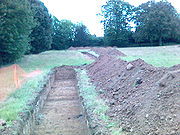
Trial trenching
Encyclopedia

Trenches are located at intervals across a site leaving the rest untouched. A mechanical excavator is used to dig down to archaeological features or natural geological deposits and any archaeology is recorded. No further excavation takes place at this stage. The results of the trial trenching are used to inform any future stage of work which may extend to full excavation of the rest of the site if the evaluation reveals significant finds.
There is some argument over the sampling strategy to be employed in trial trenching, especially in evaluating sites that are intended for development. Issues such as the effectiveness of certain trench layouts or the percentage of the site to be dug (normally around 5% at present) are widely discussed. Whether an effective picture of past human activity on a site can be truly estimated through this methods is widely debated. Development can destroy buried archaeology forever and a reliable evaluation methodology is very important. Whilst it is difficult to quantify the number of false negative
Type I and type II errors
In statistical test theory the notion of statistical error is an integral part of hypothesis testing. The test requires an unambiguous statement of a null hypothesis, which usually corresponds to a default "state of nature", for example "this person is healthy", "this accused is not guilty" or...
results there have certainly been examples of evaluations suggesting a relatively limited amount of past activity which has had to be upwardly revised during the excavation.
In the UK the results of the trial trenching will be used to inform the decision on the need for any further archaeological work to be undertaken prior to development. This process is enshrined in PPG 16
PPG 16
Planning Policy Guidance 16: Archaeology and Planning commonly abbreviated as PPG 16, was a document produced by the British Government to advise local planning authorities on the treatment of archaeology within the planning process...
and English Heritage
English Heritage
English Heritage . is an executive non-departmental public body of the British Government sponsored by the Department for Culture, Media and Sport...
's Management of Archaeological Projects colloquially known as MAP 2.
See also
- Archaeological field surveyArchaeological field surveyArchaeological field survey is the method by which archaeologists search for archaeological sites and collect information about the location, distribution and organization of past human cultures across a large area...
- Shovel test pitShovel test pitA shovel test pit is a standard method for Phase I of an Archaeological survey. It is usually a part of the CRM methodology and a popular form of rapid archaeological survey in the United States of America and Canada.It designates a series of A shovel test pit (STP) is a standard method for Phase...
- Watching briefWatching briefIn British archaeology a Watching Brief is a method of preserving archaeological remains by record in the face of development threat. An archaeologist is employed by the developer to monitor the excavation of foundation and service trenches, landscaping and any other intrusive work...
- Excavation

